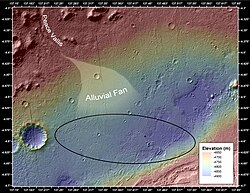皮斯谷
 | |
| 坐標 | 4°13′S 137°14′E / 4.21°S 137.23°E座標:4°13′S 137°14′E / 4.21°S 137.23°E |
|---|---|
| 長度 | 35.24公里(21.9英里) |
| 名稱 | 2012年9月26日,國際天文聯合會取自「加拿大阿爾伯塔省和英屬哥倫比亞的一條河流」名[1]。 |
皮斯谷(Peace Vallis)是火星埃俄利斯區蓋爾撞擊坑中一道似乎由流體,也許是水流蝕刻而成的河谷[2][3][4]。該河谷從蓋爾撞擊坑的山丘向東南「流入」到夏普山下附近的埃俄利斯沼,它的中心坐標為4°13′S 137°14′E / 4.21°S 137.23°E[1]。皮斯谷靠近「好奇號」漫遊車著陸點附近(布雷德伯里著陸場),漫遊車於2012年開始研究該河谷。2012年9月26日國際天文聯合會正式採納了「皮斯谷」這一名稱[1]。
「好奇號」漫遊車降落在皮斯谷沖積扇末端附近,皮斯谷沖積扇覆蓋了80公里2(31英里2)的區域,水源範圍達到730公里2(280英里2),皮斯谷通過蓋爾撞擊坑坑壁上一處15公里(9.3英里)寬的豁口進入坑內。計算表明,該沖積扇平均厚度為 9 米(30英尺),在沖積扇西部表面可看到許多倒轉河道,流經皮斯谷形成沖積扇的徑流估計寬達600 到6000米(0.37至3.73英里)之間。因此,這一水循環系統可能至少持續了數千年,在皮斯谷中流動的水流被認為可能來自融雪[5][6]。
圖集[編輯]
另請查看[編輯]
參考文獻[編輯]
- ^ 1.0 1.1 1.2 IAU Staff. Gazetteer of Planetary Nomenclature: Peace Vallis. IAU. September 26, 2012 [September 28, 2012]. (原始內容存檔於2018-06-29).
- ^ 2.0 2.1 Brown, Dwayne; Cole, Steve; Webster, Guy; Agle, D.C. NASA Rover Finds Old Streambed On Martian Surface. NASA. September 27, 2012 [September 28, 2012]. (原始內容存檔於2020-05-13).
- ^ 3.0 3.1 NASA. NASA's Curiosity Rover Finds Old Streambed on Mars - video (51:40). NASAtelevision. September 27, 2012 [September 28, 2012]. (原始內容存檔於2018-09-27).
- ^ 4.0 4.1 Chang, Alicia. Mars rover Curiosity finds signs of ancient stream. AP News. September 27, 2012 [September 27, 2012]. (原始內容存檔於2013-05-16).
- ^ Palucis, Marisa C. The origin and evolution of the Peace Vallis fan system that drains to theCuriositylanding area, Gale Crater, Mars. Journal of Geophysical Research: Planets: 705–728. Bibcode:2014JGRE..119..705P. doi:10.1002/2013JE004583.
- ^ Palucis, M.; Dietrich, W.; Hayes, A.; Williams, R.; Gupta, S.; Mangold, N.; Newsom, H.; Hardgrove, C.; Calef, III; Sumne, D. The origin and evolution of the Peace Vallis fan system that drains to the Curiosity landing area, Gale Crater, Mars. Journal of Geophysical Research: Planets. 2014, 119: 705–728. Bibcode:2014JGRE..119..705P. doi:10.1002/2013je004583.












